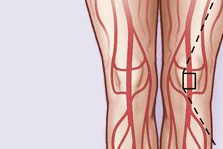Abdominal aortic aneurysm (AAA) diameter has important implications for operative and long-term outcomes for patients, based on a study of 22,975 patient records in the Vascular Quality Initiative.
Using historical data and more recent large randomised controlled trials, international societies recommend elective repair of AAA when the diameter exceeds 5cm in women and 5.5cm in men. Repair for small aneurysms may be indicated if there exists excessive growth, a saccular morphology, or family history of AAA.
Interestingly, the relatively higher proportion of elective AAA at smaller diameters in the USA is associated with lower population-level AAA-related death and rupture compared with the UK.
According to the paper’s lead author, Douglas Jones from the Boston Medical Center, “there are relatively few high-quality data describing national practice patterns and outcomes associated with AAA diameter. Using the Vascular Quality Initiative (VQI) database, we sought to describe differences in patient characteristics and selection based on AAA diameter. Secondarily, we examined the effect of AAA diameter on operative and long-term outcomes.”
As reported in the November edition of the Journal of Vascular Surgery, a multicentre team led by Jones analysed 22,975 patients enrolled in the VQI who underwent elective EVAR (endovascular aneurysm repair) from 2003 to 2017. They divided the cohorts studied into small (<5cm in women, 5.5cm in men), medium (5–6.5cm in women, 5.5–6.5cm in men), and large (>6.5cm) AAA.
Of the patients undergoing EVAR based on AAA size, 9,353 (41%) were small AAAs; 10,842 (47%) were medium and 2,780 (12%) were large.
Thirty-day mortality was found to be 0.4% among small AAAs, 0.9% among medium, and 1.6% among large AAAs.
Further, patients with small aneurysms had the lowest rates of medical complications, Type 1 endoleak at surgery and the shortest length of stay.
Five-year overall survival was predicted by AAA size at the time of EVAR with these rates: small, 88%; medium, 81% and large, 75%.
“The survival rates for patients undergoing EVAR for small AAAs were comparable to those seen in the surveillance arms of recent trials (90% at 4.5 years),” Jones said. “As a result, although these data illustrate that long-term survival is associated with AAA diameter at the time of EVAR, they should not be interpreted as supportive of EVAR for small AAAs over surveillance.”
Many factors besides maximum AAA diameter can be factors in recommending repair or surveillance, he noted.
“These data show that a large proportion of elective EVARs nationwide are being performed for small AAAs,” Jones said, “and the clinical indications for these repairs merit further study, especially given relative unanimity of guideline recommendations.”
The scholarly article is open source and available through 31 December at http://vsweb.org/JVS-AAA.












